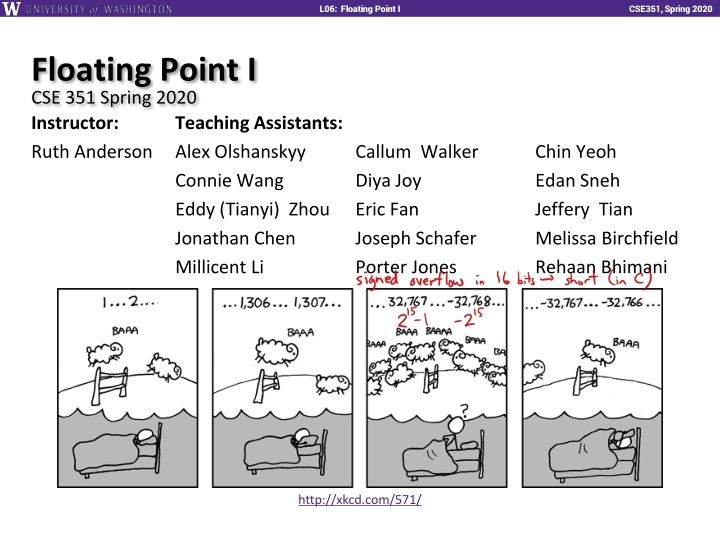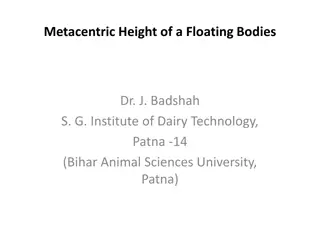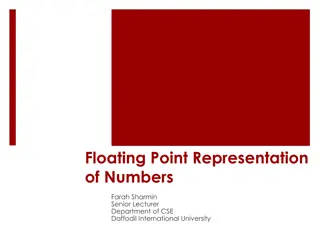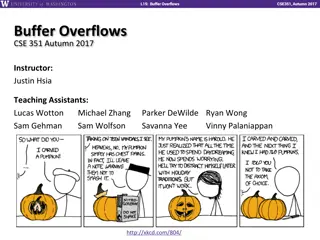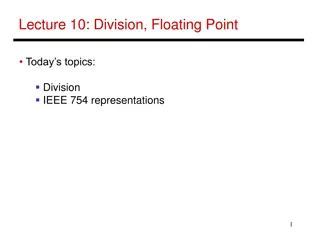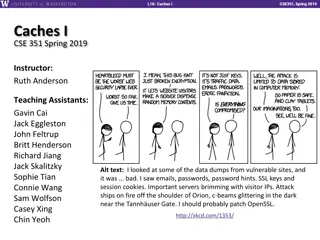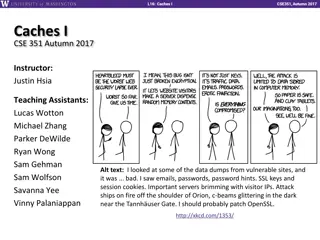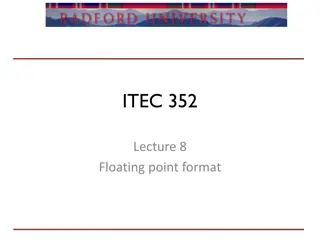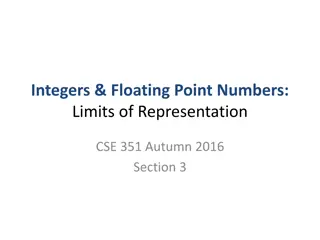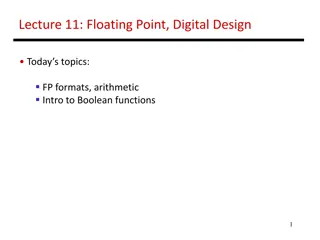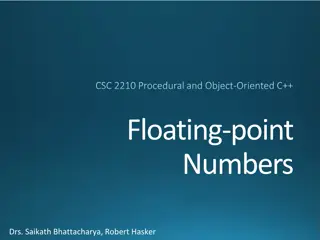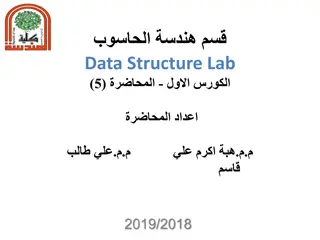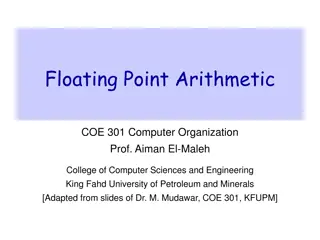Floating Point in CSE351 - Spring 2020 Lecture Insights
Delve into the realm of floating point operations as explored in the CSE351 course during the Spring of 2020. From understanding unsigned multiplication to intricate modular arithmetic implementations, this lecture series covers a range of topics. Dive deeper into the concepts behind aside discussions on multiplication in C and feedback mechanisms for group interactions. Explore the experiments, questions during lectures, and the significance of breakout groups in shaping the learning experience. Discover how the lecture format encourages engagement, interaction, and understanding in a structured online academic environment.
Download Presentation

Please find below an Image/Link to download the presentation.
The content on the website is provided AS IS for your information and personal use only. It may not be sold, licensed, or shared on other websites without obtaining consent from the author.If you encounter any issues during the download, it is possible that the publisher has removed the file from their server.
You are allowed to download the files provided on this website for personal or commercial use, subject to the condition that they are used lawfully. All files are the property of their respective owners.
The content on the website is provided AS IS for your information and personal use only. It may not be sold, licensed, or shared on other websites without obtaining consent from the author.
E N D
Presentation Transcript
L06: Floating Point I CSE351, Spring 2020 Floating Point I CSE 351 Spring 2020 Instructor: Ruth Anderson Teaching Assistants: Alex Olshanskyy Connie Wang Eddy (Tianyi) Zhou Jonathan Chen Millicent Li Callum Walker Diya Joy Eric Fan Joseph Schafer Porter Jones Chin Yeoh Edan Sneh Jeffery Tian Melissa Birchfield Rehaan Bhimani http://xkcd.com/571/
L06: Floating Point I CSE351, Spring 2020 Administrivia hw5 due Monday 11am Lab 1a due Monday (4/13) at 11:59 pm Submit pointer.c and lab1Areflect.txt hw6 due Wednesday 11am Lab 1b due Monday (4/20) Submit bits.c and lab1Breflect.txt 2
L06: Floating Point I CSE351, Spring 2020 Questions During Lecture An Experiment Asking too many questions in chat window during lecture is very distracting to some students While I am lecturing If you need to ask a question about content, please use the Google doc Staff will answer your questions in the Google doc during lecture We will reserve the chat window for short logistical questions (e.g. which slide deck? , We can t see your screen ) When I explicitly pause to take questions - Use chat window to type your question, or raise hand and I will call on you to speak We will not be saving the chat window. We WILL be saving, and anonymizing the Google doc and sharing with the class. You must log on with your @uw google account to access!! Google doc for 11:30 Lecture: https://tinyurl.com/351-04-10A Google doc for 2:30 Lecture: https://tinyurl.com/351-04-10B 3
L06: Floating Point I CSE351, Spring 2020 Groups & Feedback Groups Some classes are allowing students to pick people they would like to be in breakout groups with and stick with those same breakout groups for the rest of the quarter. We are up for trying this. Tell us what you think on this survey! Week 2 Feedback Survey https://catalyst.uw.edu/webq/survey/rea2000/388285 4
L06: Floating Point I CSE351, Spring 2020 Aside: Unsigned Multiplication in C u Operands: * ? bits v True Product: u v ?? bits Discard ? bits: UMultw(u , v) ? bits Standard Multiplication Function Ignores high order ? bits Implements Modular Arithmetic UMultw(u , v) = u v mod 2w 5
L06: Floating Point I CSE351, Spring 2020 Aside: Multiplication with shift and add Operation u<<kgives u*2k Both signed and unsigned u k Operands: ? bits 2k 0 0 1 0 0 0 * u 2k 0 0 0 True Product: ? + ? bits UMultw(u , 2k) TMultw(u , 2k) 0 0 0 Discard ? bits: ? bits Examples: u<<3 u<<5 - u<<3 == u * 24 Most machines shift and add faster than multiply == u * 8 Compiler generates this code automatically 6
L06: Floating Point I CSE351, Spring 2020 Number Representation Revisited What can we represent so far? Signed and Unsigned Integers Characters (ASCII) Addresses How do we encode the following: Real numbers (e.g. 3.14159) Very large numbers (e.g. 6.02 1023) Very small numbers (e.g. 6.626 10-34) Special numbers (e.g. , NaN) Floating Point 7
L06: Floating Point I CSE351, Spring 2020 Floating Point Topics Fractional binary numbers IEEE floating-point standard Floating-point operations and rounding Floating-point in C There are many more details that we won t cover It s a 58-page standard 8
L06: Floating Point I CSE351, Spring 2020 Floating Point Summary Floats also suffer from the fixed number of bits available to represent them Can get overflow/underflow, just like ints Gaps produced in representable numbers means we can lose precision, unlike ints Some simple fractions have no exact representation (e.g. 0.2) Every operation gets a slightly wrong result Floating point arithmetic not associative or distributive Mathematically equivalent ways of writing an expression may compute different results Never test floating point values for equality! Careful when converting between ints and floats! 9
L06: Floating Point I CSE351, Spring 2020 Representation of Fractions Binary Point, like decimal point, signifies boundary between integer and fractional parts: xx.yyyy Example 6-bit representation: 21 2-4 20 2-1 2-22-3 Example:10.10102 = 1 21 + 1 2-1 + 1 2-3 = 2.62510 10
L06: Floating Point I CSE351, Spring 2020 Representation of Fractions Binary Point, like decimal point, signifies boundary between integer and fractional parts: xx.yyyy Example 6-bit representation: 21 2-4 20 2-1 2-22-3 In this 6-bit representation: What is the encoding and value of the smallest (most negative) number? What is the encoding and value of the largest (most positive) number? What is the smallest number greater than 2 that we can represent? 11
L06: Floating Point I CSE351, Spring 2020 Fractional Binary Numbers 2i 2i 1 4 2 b 1 . 1/2 1/4 1/8 1 bibi 1 b2b1b0 b 2b 3 b j 2 j Representation Bits to right of binary point represent fractional powers of 2 Represents rational number: i bk 2k k= j 12
L06: Floating Point I CSE351, Spring 2020 Fractional Binary Numbers Value 5 and 3/4 2 and 7/8 47/64 Representation 101.112 10.1112 0.1011112 Observations Shift left = multiply by power of 2 Shift right = divide by power of 2 Numbers of the form 0.111111 2 are just below 1.0 1/2 + 1/4 + 1/8 + + 1/2i+ 1.0 Use notation 1.0 13
L06: Floating Point I CSE351, Spring 2020 Limits of Representation Limitations: Even given an arbitrary number of bits, can only exactly represent numbers of the form x * 2y (y can be negative) Other rational numbers have repeating bit representations Value: Binary Representation: 0.01010101[01] 2 0.001100110011[0011 ] 2 0.0001100110011[0011 ] 2 1/3 = 0.333333 10 = 1/5 = 1/10 = 14
L06: Floating Point I CSE351, Spring 2020 Fixed Point Representation Implied binary point. Two example schemes: #1: the binary point is between bits 2 and 3 b7 b6 b5 b4 b3 [.] b2 b1 b0 #2: the binary point is between bits 4 and 5 b7 b6 b5 [.] b4 b3 b2 b1 b0 Wherever we put the binary point, with fixed point representations there is a trade off between the amount of range and precision we have Fixed point = fixed range and fixed precision range: difference between largest and smallest numbers possible precision: smallest possible difference between any two numbers Hard to pick how much you need of each! 15
L06: Floating Point I CSE351, Spring 2020 Floating Point Representation Analogous to scientific notation In Decimal: 1.2 x 107 Not 12000000, but Not 0.0000012, but 1.2 x 10-6 In Binary: Not 11000.000, but 1.1 x 24 Not 0.000101, but 1.01 x 2-4 In C: 1.2e7 In C: 1.2e-6 We have to divvy up the bits we have (e.g., 32) among: the sign (1 bit) the mantissa (significand) the exponent 16
L06: Floating Point I CSE351, Spring 2020 Scientific Notation (Decimal) mantissa exponent 6.0210 1023 radix (base) decimal point Normalized form: exactly one digit (non-zero) to left of decimal point Alternatives to representing 1/1,000,000,000 Normalized: Not normalized: 1.0 10-9 0.1 10-8,10.0 10-10 17
L06: Floating Point I CSE351, Spring 2020 Scientific Notation (Binary) mantissa exponent 1.012 2-1 radix (base) binary point Computer arithmetic that supports this called floating point due to the floating of the binary point Declare such variable in C as float (or double) 18
L06: Floating Point I CSE351, Spring 2020 Scientific Notation Translation Convert from scientific notation to binary point Perform the multiplication by shifting the decimal until the exponent disappears Example: 1.0112 24 = 101102 = 2210 Example: 1.0112 2-2 = 0.010112 = 0.3437510 Convert from binary point to normalized scientific notation Distribute out exponents until binary point is to the right of a single digit Example: 1101.0012 = 1.1010012 23 Practice: Convert 11.37510 to normalized binary scientific notation 19
L06: Floating Point I CSE351, Spring 2020 Floating Point Topics Fractional binary numbers IEEE floating-point standard Floating-point operations and rounding Floating-point in C There are many more details that we won t cover It s a 58-page standard 20
L06: Floating Point I CSE351, Spring 2020 IEEE Floating Point IEEE 754 Established in 1985 as uniform standard for floating point arithmetic Main idea: make numerically sensitive programs portable Specifies two things: representation and result of floating operations Now supported by all major CPUs Driven by numerical concerns Scientists/numerical analysts want them to be as real as possible Engineers want them to be easy to implement and fast In the end: Scientists mostly won out Nice standards for rounding, overflow, underflow, but... Hard to make fast in hardware Float operations can be an order of magnitude slower than integer ops 21
L06: Floating Point I CSE351, Spring 2020 Floating Point Encoding Use normalized, base 2 scientific notation: Value: 1 Mantissa 2Exponent Bit Fields: (-1)S 1.M 2(E bias) Representation Scheme: Sign bit (0 is positive, 1 is negative) Mantissa (a.k.a. significand) is the fractional part of the number in normalized form and encoded in bit vector M Exponent weights the value by a (possibly negative) power of 2 and encoded in the bit vector E 31 30 23 22 0 S E M 1 bit 8 bits 23 bits 22
L06: Floating Point I CSE351, Spring 2020 The Exponent Field Use biased notation Read exponent as unsigned, but with bias of 2w-1-1 = 127 Representable exponents roughly positive and negative Exponent 0 (Exp = 0) is represented as E = 0b 0111 1111 Why biased? Makes floating point arithmetic easier Makes somewhat compatible with two s complement Practice: To encode in biased notation, add the bias then encode in unsigned: Exp = 1 E = 0b Exp = 127 E = 0b Exp = -63 E = 0b 23
L06: Floating Point I CSE351, Spring 2020 The Mantissa (Fraction) Field 31 30 23 22 0 S E M 1 bit 8 bits 23 bits (-1)S x (1 . M) x 2(E bias) Note the implicit 1 in front of the M bit vector Example: 0b 0011 1111 1100 0000 0000 0000 0000 0000 is read as 1.12 = 1.510, not 0.12 = 0.510 Gives us an extra bit of precision Mantissa limits Low values near M = 0b0 0 are close to 2Exp High values near M = 0b1 1 are close to 2Exp+1 24
L06: Floating Point I CSE351, Spring 2020 Polling Question [FP I a] What is the correct value encoded by the following floating point number? 0b 0 10000000 11000000000000000000000 Vote at http://pollev.com/rea A. + 0.75 B. + 1.5 C. + 2.75 D. + 3.5 E. We re lost 25
L06: Floating Point I CSE351, Spring 2020 Normalized Floating Point Conversions FP Decimal 1. Append the bits of M to implicit leading 1 to form the mantissa. 2. Multiply the mantissa by 2E bias. 3. Multiply the sign (-1)S. 4. Multiply out the exponent by shifting the binary point. 5. Convert from binary to decimal. Decimal FP 1. Convert decimal to binary. 2. Convert binary to normalized scientific notation. 3. Encode sign as S (0/1). 4. Add the bias to exponent and encode E as unsigned. 5. The first bits after the leading 1 that fit are encoded into M. 26
L06: Floating Point I CSE351, Spring 2020 Precision and Accuracy Precision is a count of the number of bits in a computer word used to represent a value Capacity for accuracy Accuracy is a measure of the difference between the actual value of a number and its computer representation High precision permits high accuracy but doesn t guarantee it. It is possible to have high precision but low accuracy. Example:float pi = 3.14; pi will be represented using all 24 bits of the mantissa (highly precise), but is only an approximation (not accurate) 27
L06: Floating Point I CSE351, Spring 2020 Need Greater Precision? Double Precision (vs. Single Precision) in 64 bits 63 62 52 51 32 S 31 E (11) M (20 of 52) 0 M (32 of 52) C variable declared as double Exponent bias is now 210 1 = 1023 Advantages: Disadvantages: more bits used, greater precision (larger mantissa), greater range (larger exponent) slower to manipulate 28
L06: Floating Point I CSE351, Spring 2020 Representing Very Small Numbers But wait what happened to zero? Using standard encoding 0x00000000 = Special case: E and M all zeros = 0 Two zeros! But at least 0x00000000 = 0 like integers b Gaps! New numbers closest to 0: a = 1.0 02 2-126 = 2-126 b = 1.0 012 2-126 = 2-126 + 2-149 Normalization and implicit 1 are to blame Special case: E = 0, M 0 are denormalized numbers + - 0 a 29
L06: Floating Point I CSE351, Spring 2020 This is extra (non-testable) material Denorm Numbers Denormalized numbers No leading 1 Uses implicit exponent of 126 even though E = 0x00 Denormalized numbers close the gap between zero and the smallest normalized number Smallest norm: 1.0 0two 2-126 = 2-126 Smallest denorm: 0.0 01two 2-126 = 2-149 There is still a gap between zero and the smallest denormalized number So much closer to 0 30
L06: Floating Point I CSE351, Spring 2020 Summary Floating point approximates real numbers: 31 30 23 22 0 S E (8) M (23) Handles large numbers, small numbers, special numbers Exponent in biased notation (bias = 2w-1 1) Size of exponent field determines our representable range Outside of representable exponents is overflow and underflow Mantissa approximates fractional portion of binary point Size of mantissa field determines our representable precision Implicit leading 1 (normalized) except in special cases Exceeding length causes rounding 31
L06: Floating Point I CSE351, Spring 2020 BONUS SLIDES An example that applies the IEEE Floating Point concepts to a smaller (8-bit) representation scheme. These slides expand on material covered today, so while you don t need to read these, the information is fair game. 32
L06: Floating Point I CSE351, Spring 2020 Tiny Floating Point Example S 1 E 4 M 3 8-bit Floating Point Representation The sign bit is in the most significant bit (MSB) The next four bits are the exponent, with a bias of 24-1 1 = 7 The last three bits are the mantissa Same general form as IEEE Format Normalized binary scientific point notation Similar special cases for 0, denormalized numbers, NaN, 33
L06: Floating Point I CSE351, Spring 2020 Dynamic Range (Positive Only) S E M Exp Value 0 0000 000 0 0000 001 0 0000 010 0 0000 110 0 0000 111 0 0001 000 0 0001 001 -6 0 0110 110 0 0110 111 0 0111 000 0 0111 001 0 0111 010 0 1110 110 0 1110 111 0 1111 000 -6 -6 -6 0 1/8*1/64 = 1/512 2/8*1/64 = 2/512 closest to zero Denormalized numbers -6 -6 -6 6/8*1/64 = 6/512 7/8*1/64 = 7/512 8/8*1/64 = 8/512 9/8*1/64 = 9/512 largest denorm smallest norm -1 -1 0 0 0 14/8*1/2 = 14/16 15/8*1/2 = 15/16 8/8*1 = 1 9/8*1 = 9/8 10/8*1 = 10/8 closest to 1 below Normalized numbers closest to 1 above 7 7 n/a 14/8*128 = 224 15/8*128 = 240 inf largest norm 34
L06: Floating Point I CSE351, Spring 2020 Special Properties of Encoding Floating point zero (0+) exactly the same bits as integer zero All bits = 0 Can (Almost) Use Unsigned Integer Comparison Must first compare sign bits Must consider 0- = 0+ = 0 NaNs problematic Will be greater than any other values What should comparison yield? Otherwise OK Denorm vs. normalized Normalized vs. infinity 35
